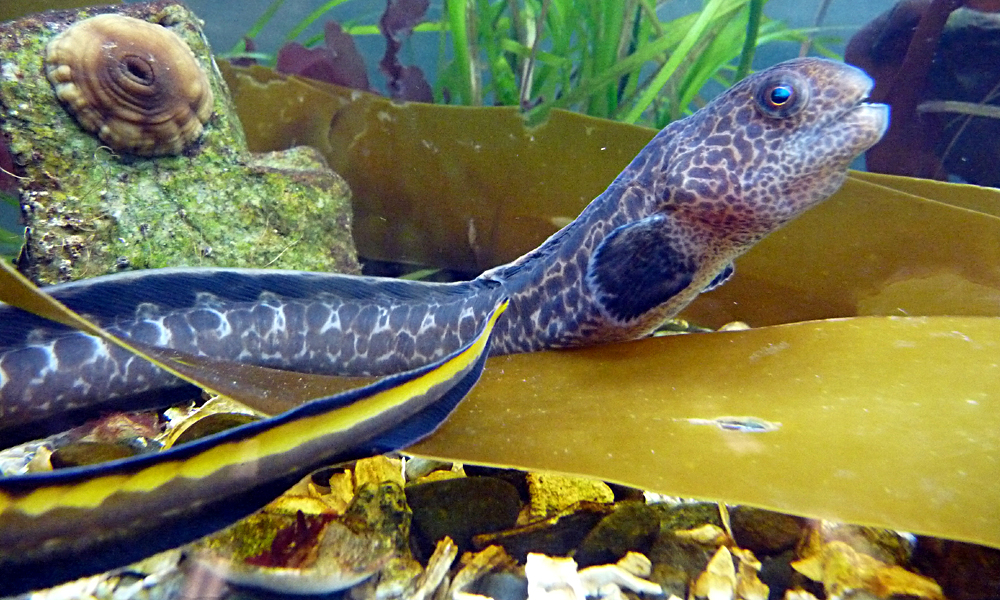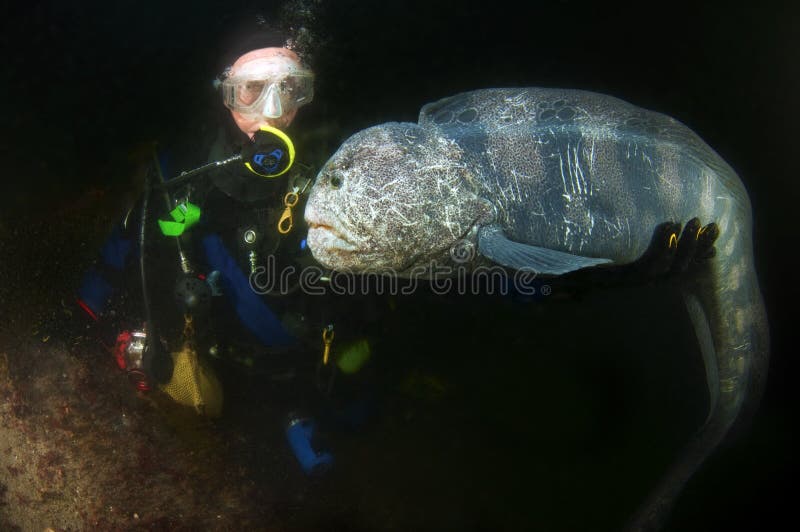

Three related species (Atlantic, northern and spotted wolffish) occur in the north Atlantic.

Since they can live in near-freezing waters (salt water only freezes at slightly below 0 ☌ or 32 ☏), to keep their blood moving smoothly, they contain a natural antifreeze. They are usually found in water temperatures of −1 to 11 ☌ (30–52 ☏). They are benthic dwellers, living on the hard ocean floor, frequently seen in nooks and small caves. Ītlantic wolffish are primarily stationary fish, rarely moving from their rocky homes. A single record was reported in 1958 from the western Mediterranean Sea in the gulf of Genoa, Italy. In the eastern Atlantic, they range from Russia's White Sea and Novaya Zemlya, through the Nordic countries and British Isles, to the Bay of Biscay. The most dense populations are in Georges Bank, the Gulf of Maine and the Great South Channel. Although they are seldom seen south of Cape Cod, there have been sightings in New Jersey. In the west Atlantic, they are present as far north as the Davis Strait, of the Canadian territory of Nunavut, populating the shores of Greenland, Newfoundland, and Nova Scotia, extending as far south as Cape Cod. Ītlantic wolffish inhabit both the west and east coasts of the Atlantic. The wolffish's throat is also scattered with serrated teeth. The lower jaw has two rows of molars behind the primary conical teeth. The central row has four pairs of molars and the outer rows house blunted conical teeth. Behind the conical teeth in the upper jaw, there are three rows of crushing teeth. Both the lower and upper jaws are armed with four to six fang-like, strong, conical teeth. Its dentition distinguishes the Atlantic wolffish from all the other members of the family Anarhichadidae. The Atlantic wolffish's distinguishing feature, from which it gets its common name, is its extensive teeth structure. Its obtuse, eel-like body type makes the fish swim slowly, undulating from side to side, like an eel. The pectorals are large and rounded and the pelvic fins are entirely absent.

An even dorsal fin extends the whole length of the back, and a similar fin from the vent to the caudal fin, as in blennies. Atlantic wolffish vary in color, usually seen as purplish-brown, a dull olive green, or blueish gray. Its body is long, subcylindrical in front, compressed in the caudal portion, smooth and slippery, the rudimentary scales being embedded and almost hidden in the skin. The largest specimen recorded measured 1.5 m (5 ft) long and weighed almost 18 kg (40 lb). The Atlantic wolffish has retained the bodily form and general external characteristics of small blennies (Blennioidei). The specific name lupus means " wolf", one of the common names for these fishes is "sea wolf", the name being given because of the canine-like front teeth. When Linnaeus described it he classified it within the monotypic genus Anarhichas so today A. The Atlantic wolffish was first formally described in 1758 in the 10th edition of the Systema Naturae by Carl Linnaeus with its type locality given as the "northern English Ocean". Wolffish population success is also an important indicator of the health of other bottom-dweller populations, such as Atlantic cod. They are also an important factor in controlling green crab and sea urchin populations, which can become overly disruptive to habitats if left unchecked. Īpart from their unique appearance wolffish are distinguished by the natural antifreeze they produce to keep their blood moving fluidly in their very cold habitat, involvement by both the male and female in brood bearing, and the large size of their eggs. National Oceanic and Atmospheric Administration's National Marine Fisheries Service. The numbers of the Atlantic wolffish in US waters are rapidly being depleted, most likely due to overfishing and bycatch, and it is currently a Species of Concern according to the U.S. The Atlantic wolffish ( Anarhichas lupus), also known as the seawolf, Atlantic catfish, ocean catfish, devil fish, wolf eel (the common name for its Pacific relative), woof or sea cat, is a marine fish of the wolffish family Anarhichadidae, native to the North Atlantic Ocean.


 0 kommentar(er)
0 kommentar(er)
